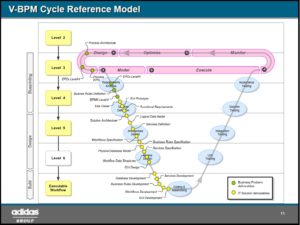Alex Peters and Derek Miers presented in the business process track with a session on BPM as the new language of IT to business technology. Forrester has been pushing the phrase “business technology” instead of “information technology” for the past year or so, and it was funny this morning to hear John Rymer say that he didn’t like the term at first, but he’s really bought into it now, since it really describes the role of IT in supporting the business, rather than off in their own world.
Peters discussed three recent technologies that have become game changers: social computing to expand the customer interaction channels, dynamic business applications for cross-functional processes, and the cloud as a delivery platform. There are also new key actors in business process transformation initiatives, characterized as VP process improvement (“change agent”), business architect (“guru”), process architect (“prodigy”), business analyst (“wannabe”), and manager of IT business systems (“operator”). Business analyst = “wannabe? That’s gotta hurt, although it was Forrester that claimed that more than half of all business analysts couldn’t cut it as a process analyst.
In moving to this new world order, where technology is focused on business, it’s necessary to evaluate the maturity of the organization’s business process management, and start the journey by eliminating waste in processes. Suddenly, this is sounding a lot like Lean. He showed some examples of companies at various stages of the journey: an organization with immature processes, where IT uses a plan-build-run structure; an aspiring organization starting to move from reactive to proactive, with more of a demand-supply structure and the beginnings of centers of excellence; and an organization with mature process management, leveraging cross-business process centers of excellence and shared services.
Miers took over to explain how the language of BPM can be used along this journey to process maturity and a business technology focus. He’s not talking about a graphical notation for process models like BPMN; he’s talking about the natural language words that we use to describe processes and process improvements, and how we need to decide what they mean. In other words, what do you mean by process? Task? Process model? Object? Capability? And does everyone else in your organization use the same words to describe the same concepts? If not, you’re going to have some alignment problems, since language is key to building a common understanding between different roles.
He stepped through each of the five actors, the challenges that they encounter in doing their business transformation work, and the language that they need to use to describe their world. Although the call to action at the end was to do your process maturity assessment and portfolio analysis, there was little of that in the rest of the presentation.
A bit of a meta topic, and a bit unfocused due in part to logistical problems at the beginning of the session, but some interesting nuggets of information.

